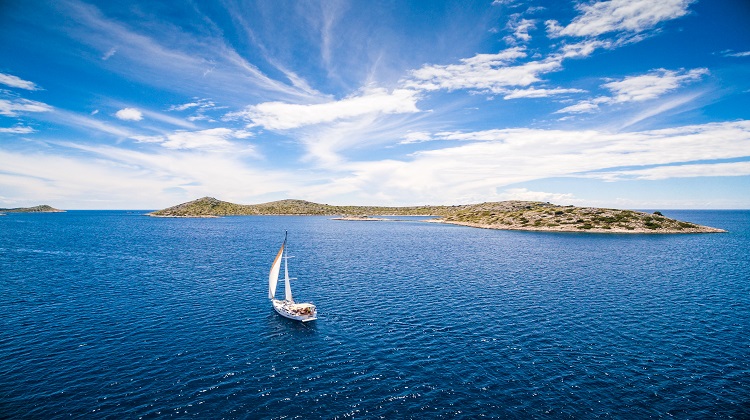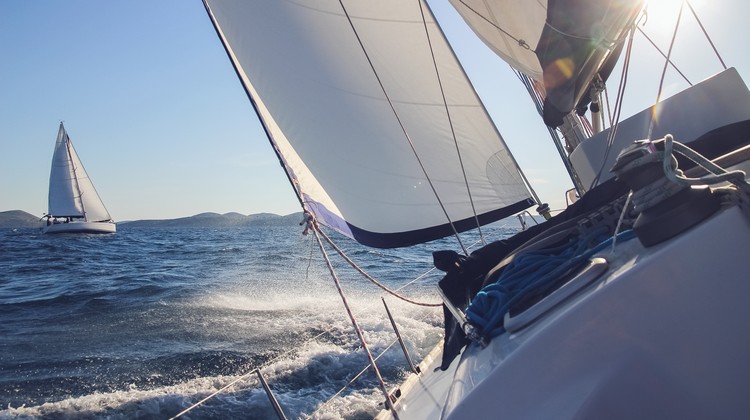Some of the most beautiful destinations in the world can be conquered with a boat.
Croatia is one of the best sailing destinations in the world. Mild climate, excellent location and good connections make indented coast of the Adriatic easily accessible throughout the year. The wealth of historical, cultural and natural heritage will surprise you with every visit. Short distances and mild climate are ideal for nautical beginners and families with children - a wide selection of something for everyone.

CLIMATE IN CROATIA - The Adriatic coast region has a Mediterranean climate whose main characteristics are dry and warm summers and humid and mild winters. The average hours of sunshine per year is 2600 especially in the central Adriatic islands. In the coastal regions, average January temperatures range from 5°C to 9°C. In August they vary from 22°C to 25°C average, with sea temperatures from 12°C in winter to 25°C in the summer. Spring and autumn (April, May and October) are usually pleasantly warm, with somewhat stronger winds, which is attractive to more experienced yachtsmen. Croatian Meteorological Service brings regularly updated weather information and forecasts for the entire country as well as general information about the climate in the area. Visit www.meteo.hr and weather forecast for the Adriatic for more information.
WINDS IN CROATIA - Croatian winds can be characterized as being light to moderate from September to June with occasional storms, while July and August are generally calm with more frequent storm. During periods of high pressure, the Adriatic displays the classic rhythms of winds from the sea during the day and winds from land during the night.
The bora (bura) and sirocco (siroko) are the most characteristic winds of the Adriatic and are largely responsible for weather patterns. They mainly blow from October to April. The maestral, blowing from the sea, and the burin, blowing from the mainland, are most common in the summer months.
ADRIATIC SEA:
SEA TEMPERATURES - The Adriatic Sea belongs to the group of warmer seas with a noticeable annual change in the surface temperature of the sea. The average annual temperature is 11°C, maximum temperatures are in July and August, and minimum temperatures in February. The lowest winter surface temperature of the sea is around 7°C but on rare occasions can be even lower. Temperatures rise in spring and reach around 18°C, and in summer rise to 22°C-25°C and in the southern Adriatic to 27°C.
 DEPTHS - The sea is the shallowest in Istria where maximum depth reaches only 50 m. From Pula, the sea bottom mildly lowers, creating a long and narrow valley, going from the island of Žirje towards Italy. This is called the Jabučka kotlina. The maximum depth reaches 240 m. From this area the seabed rises towards Palagruža Reef, lowering the maximum depth to 130 m. After this point the seabed lowers steeply towards South Adriatic Valley where the highest measured depth reaches 1,300 m.
DEPTHS - The sea is the shallowest in Istria where maximum depth reaches only 50 m. From Pula, the sea bottom mildly lowers, creating a long and narrow valley, going from the island of Žirje towards Italy. This is called the Jabučka kotlina. The maximum depth reaches 240 m. From this area the seabed rises towards Palagruža Reef, lowering the maximum depth to 130 m. After this point the seabed lowers steeply towards South Adriatic Valley where the highest measured depth reaches 1,300 m.
TIDES - Tides have relatively small amplitudes in Adriatic. In the south area, the amplitudes rarely reach 40 cm, and in Istria and Bay of Trieste it rises up to about 1 m. In narrow channels and bays, high tides can get pretty high during the strong SW wind. This phenomenon is characteristic for large and deep bays of south Adriatic. Tides change on semi-diurnal basis during the full and new moon and on daily basis during the first and last quarter. Their amplitudes are very irregular.
SEA CURRENTS - Sea currents are influenced by winds, changes in air pressure, temperatures and salinity of the sea but they don't change dramatically and do not have a significant influence on the safety of shipping. Sea currents are difficult to notice in the Adriatic. They are mostly felt when maneuvering a boat in harbors or near river mouths. Their speed changes depending on the area and seasons. Average sped is about 0.5 knots, but sometimes they can reach speed of 4 knots.
SALINITY - Average salinity of the Adriatic Sea is on average 38.3‰. Near the coast and near river mouths the salinity is somewhat lower that this figure, and it is lower in the northern compared to the central and southern Adriatic.
THE WAVES - Adriatic waves usually reach 0.5 – 1.5 m in height. Very rarely they rise above 5 m. Although they are not high, the waves in Adriatic can be very unpleasant, even dangerous, for smaller boats. Southern winds cause higher waves than the northern ones, but that doesn’t mean they are more dangerous. The highest wave ever measured caused by Jugo was 10.8 m, and from Bora 7.2 m.
 The Best Time to Sail in Croatia
The Best Time to Sail in CroatiaCroatia’s Mediterranean climate provides a fantastic environment for sailing, but like all maritime destinations, it’s important to know when the conditions are most favorable.
 Itinerary Planning
Itinerary PlanningPlanning a sailing itinerary in Croatia is an exciting task that requires attention to detail to ensure a smooth and memorable adventure along the Adriatic coast. Always plan your itinerary according to the weather forecast for the week to avoid sailing against strong winds. Apps and local weather forecasts can help monitor these conditions, ensuring smoother navigation.
Croatia’s coastline offers a variety of sailing routes, from the northern region around Rijeka and the Kvarner Gulf to the Dalmatian Coast in the south. Here are some notable destinations and what you can expect weather-wise:
To make the most of your sailing trip in Croatia, it’s essential to stay updated on local weather conditions. Several apps and websites provide live weather updates, including wind forecasts, sea state, and temperature. Some useful resources include:
Croatia’s weather is generally predictable, especially in summer, where clear skies and steady winds are common. However, sudden storms can occur in the spring and autumn, so it’s always best to monitor weather forecasts regularly while at sea.
Yes, winter sailing is possible in Croatia, especially in the southern parts where the weather remains mild. However, sailors should expect lower temperatures and potentially rough seas, especially when the Bura wind is blowing. It’s important to check the weather forecast and be prepared for more challenging conditions.
The weather in Croatia is Mediterranean, with warm summers and mild winters. During the summer, temperatures can reach 30°C (86°F), while in spring and autumn, temperatures range from 15°C (59°F) to 25°C (77°F). There’s typically lots of sunshine, with occasional showers in spring and autumn.
Yes, the northern part of the Adriatic (Istria, Rijeka, and the Kvarner Gulf) tends to experience stronger winds, particularly the Bura. In the southern Adriatic (around Dubrovnik and the islands), the winds are generally lighter, but the Jugo can occasionally bring more challenging weather conditions.
The wind, particularly the Bura and Jugo, plays a significant role in shaping sailing routes in Croatia.